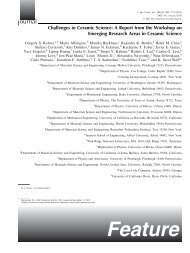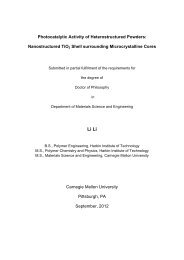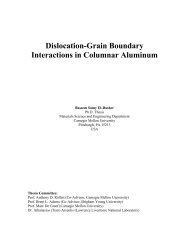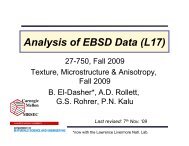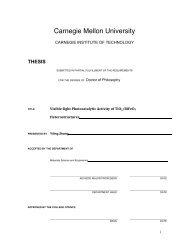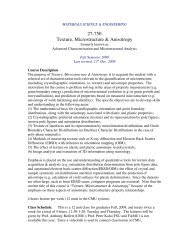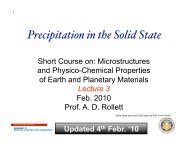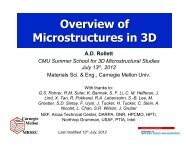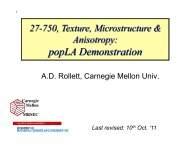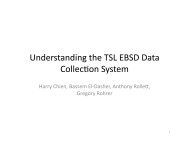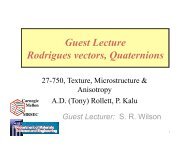¶ 3. Mathematical Representation of Crystal Orientation, Misorientation
¶ 3. Mathematical Representation of Crystal Orientation, Misorientation
¶ 3. Mathematical Representation of Crystal Orientation, Misorientation
Create successful ePaper yourself
Turn your PDF publications into a flip-book with our unique Google optimized e-Paper software.
Analysis. He labels the crystal axes as K A and the crystal axes as K B; the specimen axes<br />
are X, Y & Z, and the crystal axes are X’, Y’ & Z’.<br />
<strong>3.</strong>C.2 Correspondence between Matrices<br />
Given the orientation matrix derived from Euler angles and the matrix derived from<br />
direction cosines, one can immediately see how to convert between the various<br />
descriptions because each pair <strong>of</strong> corresponding entries must be identical to each other.<br />
That is to say, b 1 in the first matrix = cosφ 1 cosφ 2− sinφ 1 sinφ 2 cosΦ, etc.<br />
b1 Sample<br />
t1 n1 ⎛ ⎞<br />
⎜ ⎟<br />
aij = <strong>Crystal</strong><br />
⎜<br />
b2 t2 n2 ⎟<br />
⎜ ⎟<br />
⎝ b3 t3 n3 ⎠<br />
⎛ cosϕ1 cosϕ 2 − sinϕ1 sinϕ 2 cosΦ sinϕ1 cosϕ 2 + cosϕ1 sinϕ 2 cosΦ<br />
⎜<br />
≡<br />
⎜<br />
−cosϕ1 sinϕ 2 − sinϕ1 cosϕ 2 cosΦ −sinϕ1 sinϕ 2 + cosϕ1 cosϕ 2 cosΦ<br />
⎜<br />
€<br />
⎝ sinϕ1 sinΦ −cosϕ1 sinΦ<br />
sinϕ 2 sinΦ⎞<br />
⎟<br />
cosϕ 2 sinΦ<br />
⎟<br />
cosΦ ⎠<br />
This permit Euler angles to be converted to Miller indices by extracting the first and third<br />
€ columns <strong>of</strong> the orientation matrix, and re-scaling each (unit) vector to have suitable<br />
integer values.<br />
More conversions are given below.<br />
<strong>3.</strong>C.3 Other definitions € <strong>of</strong> Euler angles<br />
h = n sin Φ sinϕ 2<br />
k = n sin Φ cosϕ 2<br />
l = n cosΦ<br />
( )<br />
u = n ′ cosϕ1 cosϕ 2 − sinϕ1 sinϕ 2 cosΦ<br />
v = n ′ ( − cosϕ1 sinϕ 2 − sinϕ1 cosϕ 2 cosΦ)<br />
w = n ′ sin Φ sinϕ1 The other conventions are those <strong>of</strong> Roe [Roe, R. J. (1965). “Description <strong>of</strong><br />
<strong>Crystal</strong>lite <strong>Orientation</strong> in Polycrystalline Materials. <strong>3.</strong> General Solution to Pole Figure<br />
Inversion”, Journal <strong>of</strong> Applied Physics 36 2024], who developed an analysis in parallel<br />
with Bunge), Matthies and Kocks. The main difference between the Bunge convention<br />
and the others is that the second rotation (Θ above) is about the (rotated) X-axis, whereas<br />
in all the other conventions it is about the (rotated) Y-axis. From the (Russian) physics<br />
literature, Borisenko and Tarapov (Vector and Tensor Analysis, Dover) call them the<br />
precession, nutation and pure rotation angles, respectively, and follow the Bunge<br />
convention. Other physics literature follows the Roe convention; it would be interesting<br />
to know how the west and east came to take different approaches to Euler angles!<br />
8/27/09 8



